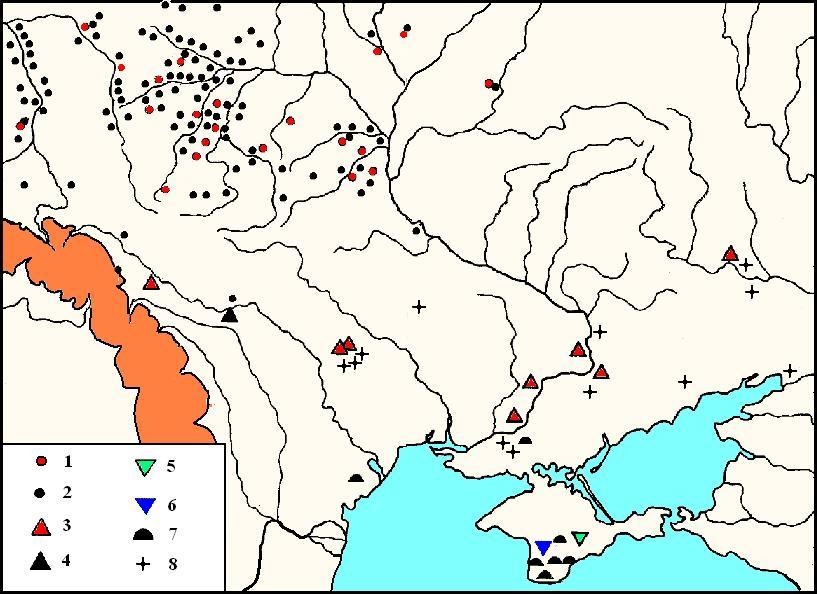Primary Settling of Eurasia by Homo sapiens
The colonization of planet Earth by neoanthropes is divided into two different but interrelated processes – migrations of carriers of certain genes or languages. If you prefer to study one of these processes, the results will differ significantly from each other. You can see this by reading the work of a Hungarian scientist (HORVÁT CABA-BARNABÁS. 2021) and the one offered here. Anticipating this, I tried to link the results of linguistic, archaeological, anthropological, and genetic studies. However, paleogenetics is still in its infancy as a science, so it is too early to draw definite conclusions.
Traces of the first people in Europe are found near the village of Vertessölös in Hungary and in the Italian town of Isernia, which date back 850-700 years. BC (DAVIES NORMAN, 2000: 87). There is a point of view that the southern regions of Eastern Europe were first populated by people of Abbevillian culture about 700 thousand years ago, before the Mindel Glaciation. This area around the Black Sea was warm even in the winter months of the year (RYBAKOV B.A., 1966: 18). However, dating sites are found controversial, and it is not excluded that they belong to the next, Acheul period. Relics of Acheulean culture in Ukraine were found in several places along the banks of the Dniester, in particular near the villages of Luka Vrublevetska and Babin (TOLOCHKO P.P., 1994: 14). The data about the Acheulian remains in other parts of Eastern Europe are not available. At least two glaciations and three warming periods during which the men retreated to the south, then back north again. Anything definite about their role in the ethnogenesis of the modern type of man can be said. In the very warm Mindel-Riss interglacial period, ie approximately 400-200 thousand years ago, a man not only settled south-west Europe (Sites Kasperivtsy, Korman on the Dniester, Peştera Kurate, Ohaba-Ponor Romania, Bojnice in Slovakia, and many others), but also penetrated to the Upper Kama, and "In the early and middle Valdai he dwelt on the Pechora" (GORIETSSKIY G.I., TSEYTLIN S.M.,1977, 17; GUSLITSER B.I., PAVLOV P.Yu.,1987: 21).
In Asia, the first man appeared much later than in Europe, but judging by archaeological finds, in his penetration into the East, he reached Altai about 300 thousand years ago. Multi-disciplinary studies have proved that the Denisova cave, located on the right bank of the Anuy River in the Altai Krai of the Russian Federation, was occupied by humans from earlier in the Middle Paleolithic to later in the Middle Ages. The genetic analyses of the small children's finger bones found in the cave revealed an unknown human type that is known as Denisovans (BERKANT E.B. 2017: 499).
The DNA of the child's finger phalanx differed from the genetic structure of modern humans by twice as many positions as Neanderthal DNA differs from ours, the study found. This suggests that Denisovans and Neanderthals followed different evolutionary paths longer than Neanderthals and modern humans. The calculations suggested that two separate lineages emerged from Homo erectus in Africa about a million years ago. One of them gave rise to Neanderthals and modern humans, the other evolved into Denisovans in Asia (KRAUSE IOHANNES mit TRAPPE THOMAS. 2020: 25).

Left: Spreading homo sapiens.
1. Homo sapiens sapiens.
2. Homo sapiens neanderthalensis.
3. Early Hominids.
Homo sapiens, the current human being, first appeared perhaps 250,000 years ago in Africa.
Genetic studies have shown "that the basic anatomy of Homo sapiens was present there by at least 150 ka" (STRINGER CHRIS. 2007: 15). And by 100,000 years ago, early modern humans were common in the Levant. Neanderthals were also present there at the same time:
… potential overlap of the emerging modern and Neanderthal clades was a consistent feature of the region during the later Middle Pleistocene, as well as the early Late Pleistocene. (Ibid: 16).
People began arriving in Europe from the Levant more than 40,000 years ago and coexisted for a long time with the Neanderthals, whose extinction process lasted for millennia and covered a vast geographical area (Ibid: 17). There is still much that is unclear to us in this process, so we will not touch on it, especially since it is beyond the scope of our topic
According to combinations of physical traits, experts distinguish among people settled in Europe two (or three) variants and connect them with the territorial "thickening" of the Upper Palaeolithic sites. One of them is located in France in the valleys of large rivers, and the other one is in Central Europe in what is now the Czech Republic and adjacent areas (BROMLEY Yu.V., 1986, 25). According to an old but well-established terminology, they are commonly known as Cro-Magnon men. The Cro-Magnons are anthropologically different from today's people except that the more massive body structure, but it pertains to the oldest representatives of Homo sapiens. Over time, in the process of cultural development (the transition to meat-eating and cooking it on the fire, etc.) structure of the human body was changed, until it acquired a modern look (JELINEK JAN. 1985. 1972: 110).
It was characteristic for the man of that time to keep the appropriate type of economy with a predominance of hunting and gathering, but the warming of the climate worse conditions for hunting due to the reduction of forest area and the onset of the dry zone from the south. Moreover, that warming made people move on to the north and north-east, reducing food bases in the form of large mammals, resulting in the growing importance of fisheries, especially in the areas with numerous lakes and marshes. People began to settle, first only during the summer, then permanently along the banks of rivers and lakes, and later on the shores of the Baltic Sea, that is, where they could fish (SAHRHAGE D., LUNDBECK J. 1992: 8). This change in the structure of the appropriating economy was a consequence of the formation of the special features in the folk psychology of the population, to a large extent determined its further cultural and historical development.
Rivers played another important role in the life of ancient people. The direction of movement of people was to a large extent determined by the structure of the hydrographic network and facilitated by the existence of natural conditions for the laying of permanent trails:
Pathways were laid in ancient times, above all, along watercourses because after the settlement a human, by their involuntary efforts, paved hiking trails mostly on the nearest to water flow terrace… The existence of other opportunities for the passing of area along other lines at later times, for example, "on the top track, "entirely on dry land, does not change anything in the way of paving the main roads. Preconditions for the emergence of hiking trails were primarily physico-geographical. Physic-Social-Geographical aspects arise from the movement of people by trials and lifestyles around them. Paths form a basic skeleton of human residence and not just a communicative one. The emergence and continued existence of settlements were the most important manifestation of the trail network. (KVĔT RADAN. 2000, 295).
Until the early Mesolithic period, the total population of the Earth consisted of only a few million people, and in the early Neolithic (the 5th millennium BC), about 10 million did. (KOZLOV V.I. 1982: 12). The majority of the population concentrated in South and East Asia, Africa, and Southern Europe, and vast expanses of the northern half of Eurasia remained almost completely deserted.
The territory of Eastern Europe began to be settled by the Cro-Magnons 15 – 12 thousand years ago, as soon as the last period of glaciation ended due to sharp warming and a reduction in the continentality of the climate. Originally, they were hunters of large mammals: mammoth, elephant, rhinoceros, and hairy rhinoceros. Warming was not gradual but there have been periods of cooling due to new attacks of glaciers from Scandinavia. However, these ripples of glaciers were diminished with distance from the Baltic, so the natural landscape of the steppe zone has been little changed since its formation in the late Tertiary (ZALIZNIAK. 1995:3). There is a classification of climatic periods, made by different researchers, which are slightly different from one another. The table below shows the periodization of the final Paleolithic according to Zalіzniak (ibid)
| 8900 BC – 81000 DC | Drias ІІІ |
| 9800 BC – 8900 DC | Allerød |
| 10000 BC – 9800 BC | Drias ІІ |
| 10400 BC – 10000 BC | Bølling |
| 11300 BC – 10400 BC | Drias І |

Left: Table of the periodization of the final Paleolithic
Right: Eightpetal mountain-avens (лат. Dryas octopetala L, photo from Wikipedia).
In the process of the gradual withdrawal of the glacier to the north, a periglacial tundra zone was formed in its place, cold and dry steppe vegetation with dominance in the eight-petal Dryas, so this period has been called Dryas. The fauna was dominated by reindeer, which became the most important staple food of the people of that time. (ZALIZNIAK L.L. 1995-1: 3)
Further to the south, forest vegetation was developed, represented mainly by pine and birch. Simultaneously the role of herbaceous and shrub formations, typical for Late Glaciation, was reduced (KHOTINSKIY N.A. 1977, 57).
Changing environmental conditions have caused, according to V. Shumkin, a crisis specialized economy of the population of Central Europe, which consisted of hunters and gatherers who were now forced to adapt to new environmental conditions between the tundra and forest, and this prevented the rapid growth of productive forces (SHUMKIN V.Ya., 1990, 10). In addition, there were no such species of plants and animals that would be fit for cultivation and domestication. All this contributed to the movement of people in search of new hunting grounds. Based on the analysis of archaeological finds, one can say that the general direction of the motion of the first group of hunters in Europe was from west to east (SAHRHAGE D., LUNDBECK J., 1992, 15).
At the same time, the transition to the hunting of small animals began, which was prepared by the development of tools, especially projectile weapons in the late Paleolithic era (FORMOZOV A.A. 1959, 68). The man knew the bow and arrow, so he could hunt not only large mammals, which at the same time had already begun to disappear, but on smaller ones, such as deer, moose, bears, deer, and hares. This happened in the final stages of cultures such as Madeleine (the 15th-10th millennium BC), whose center was in south-western France and eastern Spain, but the elements of which can be found in Germany and Poland (BRAY U., TRUMP D., 1990). Arensburgian culture, which existed in northern Germany and the Netherlands during the 9th century BC, was the development of the Magdalenian tradition.

Going for reindeer (see photo to the left from Wikipedia.), which retreated further north in the process of melting glaciers, hunter groups of periglacial Europe moved from the west to the territory of present-day Poland, and from the south or south-west – to Belarus and Lithuania. There developed two Late Paleolithic-Mesolithic cultures, the Swiderian and somewhat to the east of it Krasnoselska, based on which Pisocjnyi Riv culture developed later.
The Sviderian culture concentrated in the area of Lithuania in the 9th – 8th mill. BC, occupying also a part of Poland, Byelorussia in the south, and reaching the Carpathians but some of its elements are found even in the Crimea. The eastern boundary of this culture reached the headwaters of the Dnieper and the Volga (RIMANTENE R.K., 1971: 70, 117; KOL’TSOV L.V.,1977: 119; MEYNANDER K.F. 1974). The reason for the formation of Mesolithic cultures on these territories can be explained not only by the periglacial zone, which followed the reindeer but also by the presence of raw materials to make tools and weapons for hunting. As pointed out by E. Kalechits, the territory of Belarus is rich in easily-accessible deposits of flint, especially in the Belarusian Dnieper Region (KALECHITS E.G., 1984, 16).
Sites of Final Paleolithic (the 11 – 9 millennium BC.
The map was arranged based on Zalizniak's data (ZALIZNIAK L.L. 1995 4. Fig. 1.)
The numbers on the map signify the sites of culture: 1 – Krasnoselska. 2 – Swiderian groups. 3 – Osokoriv. 4 – Molodovo. 5 – Suren. 6 – Vyshenne. 7 – Shan-Koba. 8 – East Gravet.
Over time, people of the Arensburgian tradition have moved far to the north of Fennoskandinavia (the Komsa culture), as well as the Baltic and southern areas of Finland (the Kunda and Suomusjarvi cultures). An important role in the formation of the last was played by the carrier of the post-Sviderian traditions (SHUMKIN V.Ya., 1990, 11). With the introduction of these cultures in Europe begins the Mesolithic period which generally coincides with the transition of Earth's history from the glacial Pleistocene to the present Holocene. It is believed that the Mesolithic continued in Eastern Europe from the 9th to the 6th millennium BC (ARTEMENKO I.I. (Ed.) 1985).
Gradually moving to the northeast, the carriers of the Sviderian traditions VII – VI millennium BC reached the basin of the Oka in the 7th-6th millennium BC and seem to have moved even to the Kama, taking part in the creation of several so-called circumpolar cultures. This group of related cultures in the forest zone of Europe was extended to the north of the zone, where it was possible to practice sedentary farming. According to Gordon Childe, all forest cultures of the boreal phase, without exception, are derived from the Upper Palaeolithic cultures of Eastern and Central Europe (CHILDE GORDON. 1952: 33). Even when the Neolithic was established in the south, the population of this area continued to engage in hunting and fishing. These people wove fishing nets from bast as linden, as well elm migrated northward since the start of warming in the Boreal period, ie since the 6 millennium BC (KHOTINSKIY N.A.,1977: 59). Later they learned from south neighbors pottery and produced ovoid vessels with patching or comb patterns (BRAY U., TRUMP D. 1990).
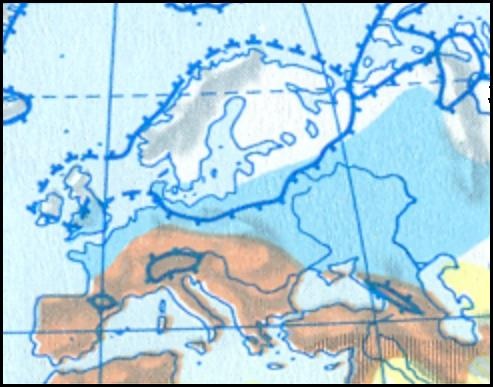
At left: Settling Europe after the last Glacial period in the 10-9 millennium BC..
The map taken from "Atlas for History" [BERTHOLD LOTHAR (Leiter). 1973. 2.IIІ].
Settling arctic hunters is shown by blue
One can also assume the resettlement of Eastern Europe in the Paleolithic and Mesolithic from the Caucasus. Archaeological materials show that the Neolithic groups from Asia Minor ran along the Eastern Black Sea region in the direction of the Kerch Strait (PAVLENKO Yu.V. 1994: 9-10).
At the time, A.A. Formozov identified in Eastern Europe since the Mesolithic three ethnocultural regions – the Southern-Russian, West-Russian, and Central (FORMOZOV A.A., 1959: 71).
He believed geometric forms as a characteristic feature of weapons of the southern Mesolithic sites. Such forms have been spread in Crimea, the Caucasus, near the Dnieper rapids, and in the Middle Don region. The western boundary of the area lay somewhere between the Dnieper and the Dniester and between the Volga and the Urals in the east. The sites having geometric shapes in the South Caucasus merge with similar relics in Iran. The northern boundary passed through the Middle Donets and the vicinity of Poltava. The central Russian region enveloping the basins of the Oka, Upper Volga, Desna, Belarus, and Lithuania was characterized by sites having tips of knife-like blades. These sites merge with Polish sites of Sviderian culture, but the full identity is not here, so A. Formozov shares this whole area with the "West Russian" and Oka groups (as it was allowed by P.P. Efimenko earlier). However, a lot to do with the Mesolithic of Poland can be found only in the western group, which includes sites of Lithuania and Belarus (Ibid., 75-77). The limits of the Central and Western Russian cultural regions remain unclear. Later A. Formozov abandoned his three-term division, as well as geometric instruments, which were also widely spread in Europe, and he admitted that "the Mesolithic characterized by geometric forms is not a narrow territorial phenomenon nor is it narrow " (FORMOZOV A.A. 1977, 59). Indeed, the geometric shape was characteristic of the arrowheads of Tardenoisian culture and this tradition spread from France through Poland to Lithuania and Belarus. However, the resemblance of geometric forms does not prove their common origin.

A study by Odessa archaeologists suggests that the bearers of Mesolithic cultures inhabited Eastern Europe also through the Balkans.
At left: Map of Mesolithic and Neolithic sites of the North-Western Black Sea Coast
(From ACNW. 2013: 14).
Legend: 1 – Skibenets node of sites; 2- Sokolets knot of sites; 3- Zankovtsy II; 4 – Pechera; 5 – Savran; 6 – Mikolina Broyaka; 7 – Gard III; 8 – Owl II; 9 – Sorotsky knot of sites; 10 – Maynova Balka; 11 – Girzhevo; 12 – Bilopilla; 13 – Myrne; 14 – Sakarivka; 15 – Dobryanka 3; 16 – Trapivka; 17 – Orlovka; 18 – Harbuzova Balka; 19 – Karpove; 20 – Konetspil; 21 – Katarzhine I; 22 – Zaliznychne; 23 – Sarateny; 24 – Dănceni; Ruseștii Noi; 25 – Bădragii Vechi; 26 – Tătărăuca Nouă XV; 27 – Novorozaivka; 28 – Novosslske; 29 – Mel'nychna Krucha .
The geometric shapes of the tools that were found on these sites say that such shapes could have developed in different places using a similar method of making them:
The developed late Mesolithic appears in the North-Western Black Sea region earlier than its European counterparts (Castelnovien and Tardenoise) – even in the Boreal period of the Holocene. The northwestern Black Sea region can be considered one of the centers for the dissemination of the technique of obtaining regular prismatic plates (by pressing and/or through an intermediary) and symmetrical micro-lytic tips in the form of trapeziums (KIOSAK D.V., PISTRUIL I.V. 2013: 23).
Thus, archaeology does not yet have reliable data for identifying any ethnocultural areas of the Mesolithic era in Eastern Europe.
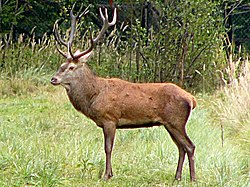
After the final melting of the glacier in Scandinavia Atlantic period begins, which is considered the Holocene climatic optimum. In the north, the tundra zone is reduced due to the onset of the taiga. Deciduous forests spread in Europe, even in the steppe zone along river valleys. At the same time, the fauna was changing – herds of reindeer were disappearing, which came to replace nongregarious ungulates – elk, round, red deer (picture from Wikipedia on the right), wild boar, roe deer.
Radical changes in the natural landscape and circumstances have also resulted in total changes in the ethnocultural situation. None of the Paleolithic cultures of Ukraine found continuation in the Early Mesolithic, which is selected by archaeologists, based on the classification of miсroliths, in five ones: Spahn-Koba, Kukrek, Zimovniki, Pisochnuyi Riv, and Kudlaevka (ZALIZNIAK L.L. 1995-2: 4-6)
The sites of Spahn-Koba culture are concentrated in the mountainous part of Crimea, where there are also cultural monuments of Kukrek, but it is more common in the Black Sea steppes. This culture is unique in the Mesolithic in Europe if we consider flint products. The economy of Kukrek was based on hunting for hoofed animals, but findings give grounds to speak about the beginning of the development of livestock among the Kukrek population. The influence of this culture spread to the shore of the Sea of Azov and Polesie. It is considered to be autochthonous (ibid: 6-10)
Pisochny Riv culture was common in the central part of Eastern Europe and had several options. It is considered to be a continuation of the Arensburgian tradition. Zymivnuky culture has some common features with Pisochnyi Riv, monuments which are known on the Right bank Forest-steppe. Kudlaevka culture has Arensburgian features too, but of another type, common in Polesie (ibid, 10, 12, 13). Three creators of these cultures migrated into Eastern Europe from Central Europe.
Right: Sites of Early Mesilothis of Ukraine in the 8 – the 7 millennium BC
An original of the map (ibid: 6, Figure 1.) tinted by the author
Legend:
1. – Pisochny Riv culture
2. Kudlaevka culture
3.Kukrek culture.
4. Zymivnyky culture.
In the vast majority of cases, the languages of all these people discussed have not survived. They are classified as Paleo-European and Paleo-Asiatic. There is scant historical information about some of the peoples who spoke them; in Europe, these were the Ligurians, Turdetani, possibly the Iberians, and others. Scientists are trying to reconstruct the languages of these peoples by studying the surviving toponymy of unknown origin. In addition to toponymy, the linguistic substrate that must exist in modern languages, which can be found in their etymologization, can help. When restoring these languages, one should proceed from the idea of the first sounds of human speech (see Reasoning on the Origin of the Human Language). In Asia, Paleo-Asiatic languages existed until new times, and one of them, Ket, has survived to this day. It belongs to the Yeniseian languages, which were spoken by the now extinct Arins, Asans, and Kotts. The anthropological features of the most ancient population of Eurasia have been preserved in genetics, and archaeological finds provide an idea of their culture.
Data on the settlement of Eurasia by the closest ancestors of modern humans by language were obtained in the process of studying the relationship of the Nostratic and Sino-Tibetan languages using the graphoanalytical method. The similarity of their graphic models allowed us to assume that the formation of the proto-languages that gave rise to these large macrofamilies occurred in the same place. It was previously determined that the Nostratic proto-languages were formed during the Mesolithic in the territory of Transcaucasia and the Armenian Highlands in the area of the three lakes of Van, Sevan, and Urmia. Therefore, it was accepted that the Sino-Tibetans inhabited the same places. The formation of separate languages occurred in the same ethno-forming areas around Mount Ararat.
In search of shelter during the cold season, the population of the Levant developed cave dwellings in the Caucasus much earlier than the neighboring regions of the Middle East. The Caucasus occupies one of the first places (and possibly the first) in the number of sites of ancient stone man (LUBIN V.P. 1998, 49). Intensive settlement of this mountainous country by the Sino-Tibetans took place in the early Paleolithic, and further, this tradition was continued by the Nostratic peoples.
Ethno-forming areas in the Three Lakes region
(The markings are on the NASA photo)
It seems incredible that with the Near-Asian origin of the Sino-Tibetans belonging to the yellow race, this race could have formed somewhere near their modern places of settlement under the influence of local natural conditions and then spread over a huge space in a completely different environment. One can think so following logic, but the scientific world is inclined to this idea in the course of genetic research:
… many ‘ancient’ DNA markers being picked up outside of Africa and enlisted to argue for gene low from extra-African archaics.., could eventually turn out to be have been carried from Africa in modern human dispersals, followed by subsequent major frequency changes between Africa and the outside (STRINGER CHRIS. 2007: 17).
Continuing to think logically, it should be borne in mind that it is difficult for descendants to get rid of specific Mongoloid features – narrow eye slits and epicanthus. Since during the migration of the peoples, some portion of them remained always on former habitats, then, assimilated by Caucasiods later, Sino-Tibetan ancestors still had to have some Mongoloid features. And as it turned out, evidence of this exists. Some researchers have paid attention to the narrow-set eyes of figures in the early Sumerian reliefs. For example, see. Fig. below.
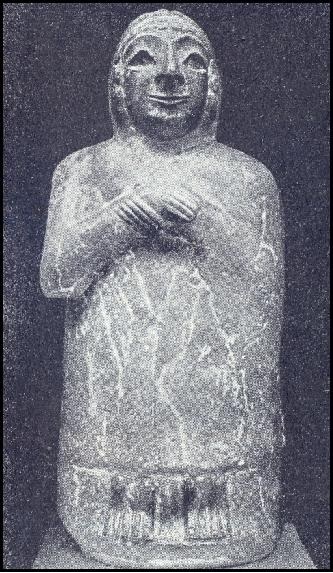
Left: The statue of a noble Sumer. Lagash. Around 2500 BC.
Statue of noble Sumer shows lightly narrowed man's eyes. In addition, the figure can be assumed to have epicanthus, an upper eyelid crease. These may be signs of residual cross-breeding Caucasoids with Mongoloids. The fact that these features are expressed rather weakly, can be explained by the fact that Mongoloids left Schumer several millennia ago.
It is generally recognized that the Sumerians were not Semites, although their origin is one of the unresolved mysteries of history. Sumerian language has just as little in common with Semitic, as well as other great known languages (KRÄMER WALTER, 1971, 67). The idea of the West Asian origin of the Sino-Tibetans in various versions is not new and is based both on a certain similarity between Chinese and early Akkadian hieroglyphs and on the discovered lexical correspondences between the Chinese and Sumerian languages. E.T. Williams, like other scientists, thought that they had some features of Turan, and therefore came to this conclusion:
We have, then, the facts that various Chinese tribes appear to have come there what is now China from some region to the northwest of that country and that the Sumerians appear to have come into the Euphrates Valley from someplace to the northeast of Babylonia; that the Sumerians were apparently of the Turanian race, and that their language and their script are strikingly like those of the ancient Chinese; and that extensive changes in the climate of Central Asia have driven out at different periods great numbers of the inhabitants who have migrated in various directions. It does not seem at all improbable that the Chinese forefathers and the ancestors of the Sumerians may have been related and may have migrated from neighboring regions, the Chinese toward the east and the Sumerians toward the west. (WILLIAMS E.T., 1918: 211).
The residence time of the Sino-Tibetan population in the ancestral home should be attributed to the Upper Paleolithic, because later this place was populated by speakers of the Nostratic languages, who arrived here from the west, pushing indigenous peoples to the east and assimilating or destroying their remains. The Sino-Tibetans migrated to Central Asia, where they became the founders of the local Mesolithic cultures. They arrived at the present location of the dwelling already in the Neolithic, or brought it with them, since reliable traces of the Mesolithic were found neither in China nor Burma. The Yangshao Neolithic culture in the middle reaches of the Huang Ho River existed from V-II thousand. BC.
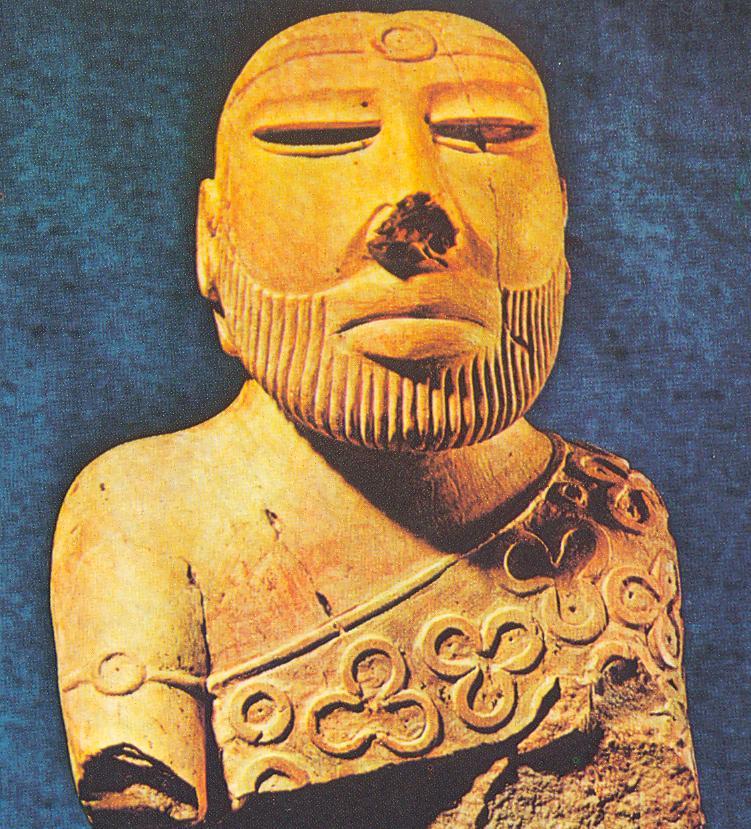
Right:
Statue of a bearded priest from Mohenjodaro.
The people of the Mongoloid race remained in Central Asia before the Dravidian people came here. The presence of Mongoloid traits in a priest from Mohenjodaro may confirm this assumption
Typological heterogeneity of people of different races in the Upper Paleolithic was smaller than it is now. (SHCHOKIN HEORIY, 2002: 77). In other words, the difference between the prototypes of people of Caucasoid and Mongoloid races was insignificant and they lived under the same environmental conditions in Asia Minor. After the Mongolians migrated through the wide-open spaces of Asia, their original phenotypic traits have been developed in different ways under the influence of the natural conditions of different habitats.
The yellow race also includes the American Indians, the peoples of the Mongolian and Tungus-Manchu language groups. When deciding the origin of this race, it should be noted that the American Indians do not have an epicanthus, and the Ainu, the ancient population of Japan, Sakhalin, and the Kuril Islands, generally have some clearly expressed European features. A full set of Mongoloid features can be found in the population of Southeast Asia, the peoples of the Mongolian and Tungus-Manchu groups. The languages of the latter do not contain clear signs of kinship with the Sino-Tibetan, i.e. they were formed very far from the settlements of the Sino-Tibetans, so it can be assumed that people of the yellow race inhabited a huge space in Eastern Europe and Asia at a time when human speech was only in the initial stage of its formation.
According to anthropological studies of the Upper Paleolithic settlements near the village of Kostenki, the representatives of all main racial groups of Europe have lived in this place on the river Don (Istoriya SSSR, 27). The analysis of numerous Epi-Paleolithic finds of skulls in Bavaria gives the following results: Nordic element – 14.4%, Lappish – 54.2%, Mediterranean – 31.4%. (CZEKANOWSKI JAN, 1957, 30). Mongoloid features distinguish the Early Neolithic population of the Yelshansk culture which was prevalent in the area between the Low Volga and the Urals. At least some of the skulls found in a few burials of this culture can be attributed to the Lappish type.
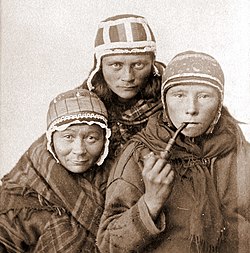
Left: Three Saami women. The 1890. Photo from Wikipedia
Since the Saami race is intermediate between Mongoloid and Caucasoid, the presence of Saami element in Epi-Paleolithic finds of skulls in Eastern Europe may indicate that at Upper Paleolithic there occurred cross-breeding of anthropologically different ethnic groups, which eventually led to a special variety of racial types, which are now generally referred to the yellow race.
Genetics offers a tentative explanation for this crossbreeding. During the Neolithic, Europe was shaped by two genetic blocks: the DNA of early hunter-gatherers and the DNA of farmers who migrated from Anatolia. These have survived to this day. However, there is another genetic pillar, strongly marked in northern and eastern Europe but at least visible in the rest of the continent. It has survived to an even greater extent in the Native Americans. It is believed that America was populated via Asia, so genetically it should be closer to America than Europe, but the opposite is true: genetically, Europeans are more related to the indigenous people of America than people of East and South Asia (KRAUSE IOHANNES mit TRAPPE THOMAS. 2020: 114). Genetic studies of the Laponoids may explain this contradiction.
The resettlement of people in those ancient times was caused by the local population pressure due to its increase within a community, or through its increase among neighboring tribes. (KOZLOV V.I., 1982, 17). Hunters moved in groups of about 25 people. This team can not be a tribe. It does not coincide with a father's kin. As it was pointed out by S. Arutyunov, "tribe, consisting of such groups, each of which requires at the most favorable conditions not less than 400-500 square meters of hunting territory, but often the area 2-3 times greater, can not be soldered, or numerous" (ARUTIUNOV S.A. 1982, 65). Thus, the resettlement of primitive people on the vast expanses of Eastern Europe could itself delay their progress rather than promote it, because arriving in an unfamiliar environment, people had to spend time and energy to adjust to new conditions of existence (KOZLOV V.I, 1982, 14).
The picture made above of the resettlement of the primary population of Eastern Europe is hypothetical and greatly simplified. All these questions are not resolved, so the purpose of this chapter was to show the options for primary ethnogenic processes until they can be spoken about more confidently. However, in keeping with the theme of this work, we will be more interested in the question if the first gatherer-hunters could create persistent ethnic groups. In considering the item, we have in mind such statements:
An ethnic community is usually defined as a collection of people with a common culture, speaking generally the same language and perceiving their community as different from people belonging to other similar communities (SEMIONOV Yu.I. 1986, 73).
Ethnicity is a stable, historically developed community of people characterized by such features, and attributes as a common territory, language, economic ties, cultural way of life, and ethnic identity, which is expressed primarily in the minds of the real or imaginary community of their origin (KOROLUK V.D. 1985., 134).
The above-mentioned characteristics and properties constitute a stable structure that allows an ethnic group to survive for a long time in different historical periods, even after the loss of one of the characteristics, provided that self-awareness is preserved. Thus, we come to the question of the role of heredity in ethnic group formation. Certain features of physical structure and character formed under the influence of the environment are transmitted from generation to generation by different mechanisms:
Genetics of behavior studies the basics of behavior and all associated with it – mental illness, a propensity for divorce, political preferences, and even a feeling of satisfaction with life. Evolutionary psychology is looking for mechanisms through which these features pass from generation to generation. Both approaches suggest that nature and education are involved in the formation of behavior, thoughts, and emotions, but in contrast to the practice of the twentieth century, nature has preference now (CSIKSZENTMIHALYI MIHALY. 2008: 89)
Genetics manifests itself at the individual level, and evolutionary psychology is a social mechanism, but they operate interconnectively. During the Paleolithic and Mesolithic, promiscuity reigned among people, but evolutionary psychology resulted in the development of endogamy, which led to the creation of certain ethnic groups in which distinct genes predominate. Suggesting all the facts known to us, it must be recognized that the first settlers in Eastern Europe were at such a low level of social development that there can be no talk of the existence of any ethnic units. However, these people formed the anthropological basis for the ethnogenetic processes that began in a later era.


